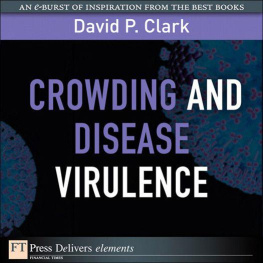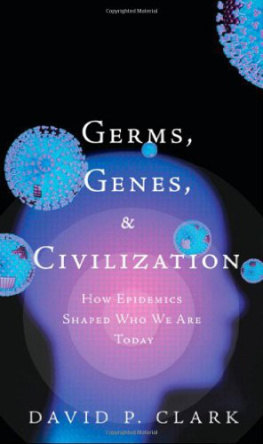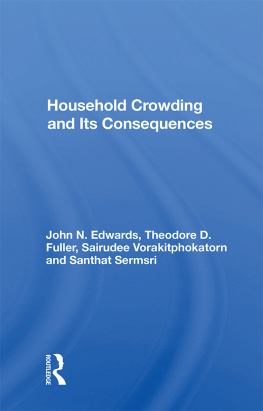David P. Clark - Crowding and Disease Virulence
Here you can read online David P. Clark - Crowding and Disease Virulence full text of the book (entire story) in english for free. Download pdf and epub, get meaning, cover and reviews about this ebook. year: 2010, publisher: FT Press, genre: Romance novel. Description of the work, (preface) as well as reviews are available. Best literature library LitArk.com created for fans of good reading and offers a wide selection of genres:
Romance novel
Science fiction
Adventure
Detective
Science
History
Home and family
Prose
Art
Politics
Computer
Non-fiction
Religion
Business
Children
Humor
Choose a favorite category and find really read worthwhile books. Enjoy immersion in the world of imagination, feel the emotions of the characters or learn something new for yourself, make an fascinating discovery.
- Book:Crowding and Disease Virulence
- Author:
- Publisher:FT Press
- Genre:
- Year:2010
- Rating:4 / 5
- Favourites:Add to favourites
- Your mark:
- 80
- 1
- 2
- 3
- 4
- 5
Crowding and Disease Virulence: summary, description and annotation
We offer to read an annotation, description, summary or preface (depends on what the author of the book "Crowding and Disease Virulence" wrote himself). If you haven't found the necessary information about the book — write in the comments, we will try to find it.
Crowding and Disease Virulence — read online for free the complete book (whole text) full work
Below is the text of the book, divided by pages. System saving the place of the last page read, allows you to conveniently read the book "Crowding and Disease Virulence" online for free, without having to search again every time where you left off. Put a bookmark, and you can go to the page where you finished reading at any time.
Font size:
Interval:
Bookmark:

David P. Clark
Earlier thinking held that, given time, all diseases would adapt, to become no worse than measles and mumps. Virulent diseases were newcomers, not yet adapted to a state of biological dtente with their human hosts. This viewpoint sees man and his infections in a perpetual cold war, with casualties due only to occasional misunderstandings. This wishful thinking has obvious marketing appeal and still frequently appears in books and articles that popularize biology.
This scenario ignores the ugly side of both evolution and human history. The inhabitants of our history books did not merely suffer from childhood diseases while their mothers read them stories about rabbits and mice dressed in human clothes. Until our own privileged age, most people died of infectious disease, much of which small rodents spread. The purpose of evolution is not to make life better for humans, nor even to produce a balanced ecosystem. Indeed, the very idea that evolution has some underlying moral purpose is basically religious. Evolution is simply a mechanism by which different living things compete using various genetic strategies. Those that propagate their own kind more effectively increase in numbers, and the less efficient go extinct. Mother Nature has no maternal instincts.
No absolute reason exists for why a disease should not remain virulent, nor why it should not get more virulent. Some do. Indeed, the same disease may fluctuate in virulence as conditions change. The critical issue is which factors promote decreased virulence and which promote increased virulence. The two main factors are overcrowding and transmission mode. Consider again two variants of the same disease, one mild and the other virulent. If humans are closely crowded, the virulent version has the advantage: There is no need for the patient to linger for several days to pass on the germs. As long as plenty of new victims are available nearby, the best strategy is for the disease to grow as fast as possible inside the original victims, generating more germs to infect more people. The slower, milder version of the disease will be left behind. Diseases tend to grow in virulence when their hosts are plentiful and crowded closely together. Conversely, diseases evolve with lesser virulence when their hosts are few and far between.
A highly virulent epidemic may wipe out a substantial portion of the human population. This decreases crowding, which, in turn, selects for a decrease in virulence. Ultimately, you might think, a balance will be struck and both the population density of the host and the virulence of the infectious agent will settle down to a gentlemanly compromise. This is the microbiological version of the famous balance of nature myth. But instead of reaching a state of stable equilibrium, periods of population growth generally alternate with devastating epidemics. Chinese records illustrate this effect. Between 37 A.D. and 1718 A.D., 234 outbreaks were severe enough to count as plaguesthats one every seven years. Although not every epidemic covered all of China, the frequency is impressive.
Bubonic plague provides a nice example of a disease whose virulence oscillated. Beginning in the mid-1300s, repeated epidemics of bubonic plague swept across Europe until the 1600s (later in some places). When plague first reached a town or city, the first few cases were usually mild and the victims recovered. Once within the crowded confines of a town, the plague became more virulent, often switching to its pneumonic form, which is spread through the air by coughing. Anyone who caught pneumonic plague could be dead within a day. From the germs viewpoint, this is no problem, provided humans coughed germs over and infected another victim within this time. In a crowded medieval city, this was normally the case. Toward the end of an outbreak, most of the population either was dead or had recovered and become immune. Hence, the plague became milder again as the number of available victims became fewer and farther between. The mild forms then spread to the next city, and the cycle repeated. After a couple generations, the population recovered to where it could provide a sufficient supply of fresh victims, and the plague might revisit the original city.
Note the time scale. Microorganisms evolve so fast that they can change their mindsor, rather, their genesduring the course of an epidemic lasting less than a year. As illustrated by the Black Death in a single city, mutants with increased virulence may appear and spread in only a few weeks, and the reverse occurs toward the end of the outbreak. Thus, the virulence of a disease such as plague neither decreases nor increases; it oscillates. A major problem for the historian is that if a disease can change significantly in a year, how did it behave a hundred years ago? A thousand? Ten thousand?
Today the human population is exploding. In many Third World countries, this is exacerbated by poor hygiene. Consequently, we can expect diseases that are efficiently transmitted from person to person to become more virulent. In addition, more people need more food. The tendency is to plant larger areas with the same crop, to improve efficiency. However, such crowding makes crops more susceptible to epidemics, just as with humans. The best-known crop disaster was the Irish potato famine, which resulted from over-reliance on a single crop. When a virulent strain of blight fungus wiped out the potatoes, the Irish had little left to eat. Infectious disease then followed in the footsteps of malnutrition. Starvation itself killed relatively fewmost victims died of cholera, dysentery, or typhus fever. Thus, crop failures and malnutrition amplify the effects of infectious disease.

If you liked this Element, you might like the book by David P. Clark, Germs, Genes, & Civilization: How Epidemics Shaped Who We Are Today (ISBN: 978-0-13-701996-0).

Vice President, Publisher: Tim Moore
Associate Publisher and Director of Marketing: Amy Neidlinger
2010 by Pearson Education, Inc.
Publishing as FTPress Delivers
Upper Saddle River, New Jersey 07458
Company and product names mentioned herein are the trademarks or registered trademarks of their respective owners.
All rights reserved. No part of this book may be reproduced, in any form or by any means, without permission in writing from the publisher.
ISBN-10: 0-13-210222-6
ISBN-13: 978-0-13-210222-3
For more information, please contact us at

Do You Love Shrimp?
Dont just eat shrimp: discover their amazing story!
Jack and Anne Rudloe
ISBN: 978-0-13-706162-4
$1.99

How Brains Seem to Work
Why the conventional explanations of how brains work is wrongand a far more promising direction for research.
Dale Purves
ISBN: 978-0-13-210213-1
$1.99

Shrimp to Eat and Shrimp to Heal
Next pageFont size:
Interval:
Bookmark:
Similar books «Crowding and Disease Virulence»
Look at similar books to Crowding and Disease Virulence. We have selected literature similar in name and meaning in the hope of providing readers with more options to find new, interesting, not yet read works.
Discussion, reviews of the book Crowding and Disease Virulence and just readers' own opinions. Leave your comments, write what you think about the work, its meaning or the main characters. Specify what exactly you liked and what you didn't like, and why you think so.












